
Für eine deutsche Übersetzung dieser Seite einfach die Brandenburger Flagge anklicken
 |
Click the Brandenburg Flag for a German translation Für eine deutsche Übersetzung dieser Seite einfach die Brandenburger Flagge anklicken |


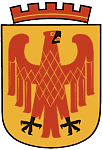 |
Home Towns - Potsdam, GermanyFriendship Island |
 |



 |
This site is part of our Potsdam site. Click the left turn sign to get back to the
Potsdam Start Site. If you came here from our Vacation 2010 sites, click the green traffic light to return. |

|


 While Potsdam is most famous for its world heritage sites, the castles of Sanssouci and Babelsberg, amongst others, it also has a lot of local parks of which the Friendship Island (Freundschaftsinsel in German) is definitely the most popular one. The island is named after a restaurant that has been in this place for more than 150 years. |

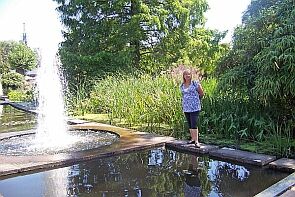 |
Originally just an alluvial sand island in the Havel river, the island was first populated by local
farmers and ship builders in the 19th century. In 1938, gardener and botanist
Karl Foerster
started creating a botanical garden on the island which opened in 1941. Unfortunately all his original work was destroyed just four years later
in one of the last battles of World War II. After the war, the island was scattered with trenches while local citizen planted vegetables to
survive the harsh past-war conditions.
 Starting in 1951, the island was turned into a park again and today it is not only one of Potsdam’s most popular inner city parks but also host to the state’s largest collection of modern sculptures and Germany’s largest garden of perennial plants. |


Friendship Cafe |
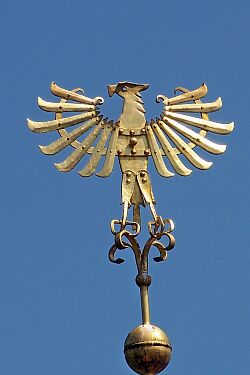 |
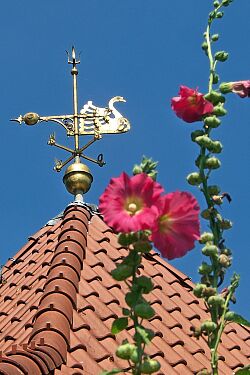 |
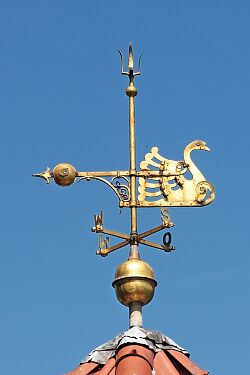
|

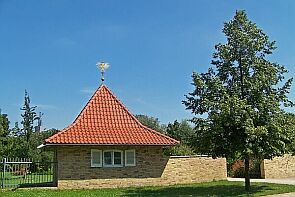 |
Eagle and Swan are the two most iconic animals in Potsdam. The eagle has been Brandenburg’s heraldic animal for hundreds of years.
 The swan, on the other hand, is closely related to the river Havel, which circumfluents the island. |

|
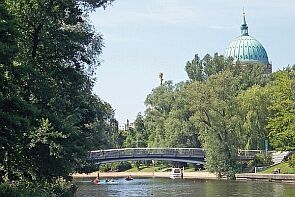 |
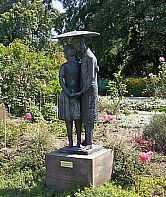 |
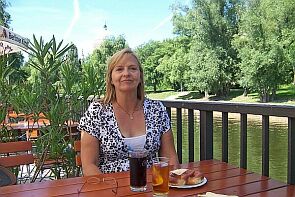
|
| One of two bridges leading to the island | Judy, testing German pretzels at Friendship Cafe |

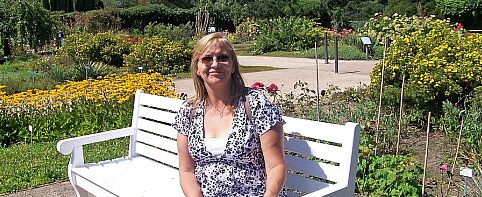 |
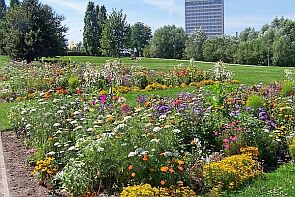
|


Botanical Garden
|

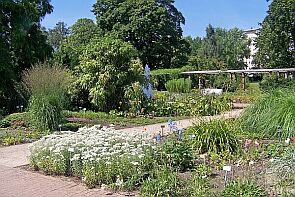 |
"We bloom throughout the entire year" was the motto of German gardener, botanist, writer and philosopher Karl Foerster (1874-1970), lover of perennial plants, many of which have indeed long blooming periods. His first book "Winter-Hardy Perennial Plants" was published in 1911 and was followed by many publications throughout his life. As a gardener, Foerster bred 362 new species of aster, larksour, and grass. His greatest accomplishment was the botanical garden at Friendship Island, founded in 1941. The original garden was destroyed at the end of World War II and a new attempt in the 1960 fell victim to vandalism and was moved to a safer location but never really took off again. In 1996, Potsdam was designated to host the 2001 Federal Horticulture Show. As part of the show, it was decided to restore Foerster’s work. In a Europe-wide search, 204 of Foerster’s 362 original plant creations were located and brought back to their original place, creating Germany’s largest garden of perennial plants. In addition to the perennial plant garden, there is now a rock garden and a water plant garden, covering a total of 17 acres and hosting a total of 1,200 plant species, making it Potsdam’s most popular inner city park. |

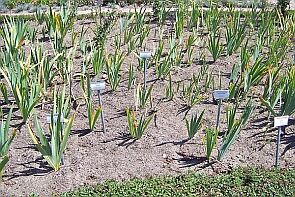 |
How do you know it is a Botanical Garden? Botanical Gardens are not only there for esthetical purposes but also serve science and education, and sometimes, well, there are more signs than plants: |
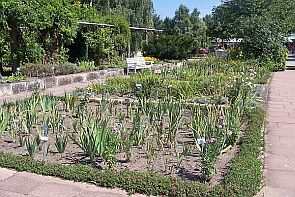
|
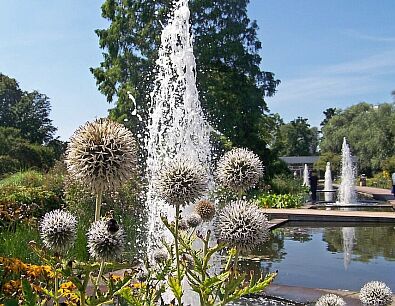 |
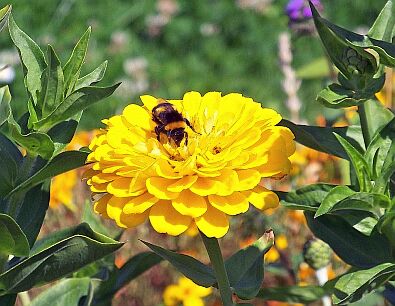
|
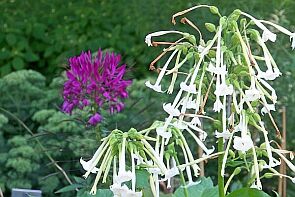 |
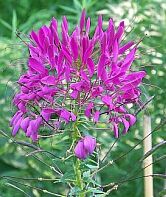 |
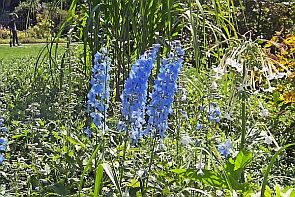 |


Main Fountain
|

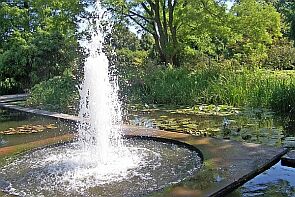 |
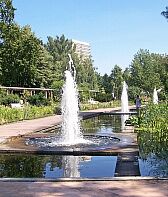 |
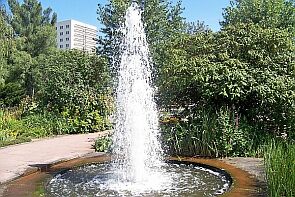
|

| The main fountain provides a nice background for some of the exhibits of the Sculpture Garden as well as habitat for the Botanical Garden on the island. It consists of three individual fountains, each with its own basin. |

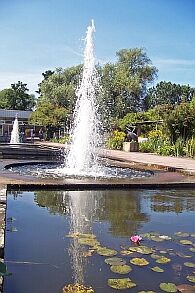 |

|
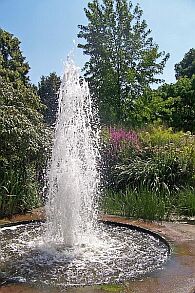
|


Sculpture Garden
|

 |
 |
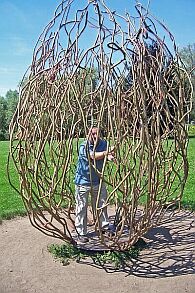
|


"Miracle" is a moving sculpture created by local artist Rainer Fürstenberg. We tried to catch the motion.
|


|
Beauty of People in Nature M. Middell, 1974 
|
Take the TourIn addition to the pictures we took, we’d like to give you the complete tour. There is a good website about the park, but unfortunately, it is in German. Below, we took the pictures from that site and translated the sculpture’s names to the best of our knowledge.The sculptures are in the order as you would see them walking from west to east across the island, starting at the main entrance and ending at the eastern tip. |
|
Miracle Rainer Fürstenberg, 2003 |
 Florales Gitter
Florales GitterFloral Grid Ch. Roehl, 1972 |
Dancers I Hunzinger-Frank, 1962 
|
|
Adornment Wall H. Bollhagen, 1973 |
Lovers under Umbrella J. v. Woyski, 1962 |
Young Gardener K.-H. Schamal, 1963 
|
|
Inge W. Arnold, 1949 |
Ceramic Wall E. Wrobel, 1973 |
Combing Woman G. Rommel, 1966 
|
|
Pelicans H. Klakow, 1956 |
Standing Girl Fritz Kremer, 1960 |
 Bär
BärBear St. Horota, 1964 
|
|
Young Fox St. Horota, 1966 |
Youth H. Misch, 1979 |
 Spielfigur Frosch
Spielfigur FroschPlay sculpture Frog R. Sperl, 1987 
|
 Spielfigur Vogel
Spielfigur VogelPlay sculpture Bird R. Sperl, 1987 |
Homage to Karl Foerster Ch. Roehl, 1974 |
Swimmer Fritz Kremer, 1959 
|
 Windspiel Fisch
Windspiel FischWind sculpture Fish S. Petit & G. Roßkamp, 2001 |
 Windspiel Vogel
Windspiel VogelWind sculpture Bird S. Petit & G. Roßkamp, 2001 |
Pony H. Drake, 1964 
|
|
Children Drawing H. Klakow, 1965 |
Friendship Fountain Wenske, Dübel, Bachman, 1973 |
Harmony D. Rhode, 1965 |



 |
This site is part of our Potsdam site. Click the left turn sign to get back to the
Potsdam Start Site. If you came here from our Vacation 2010 sites, click the green traffic light to return. |

|

 Back to Potsdam Page |
 Back to Home Towns |
 Back to Germany Page |
 Back to English Main Page |
 Back to Start Page |